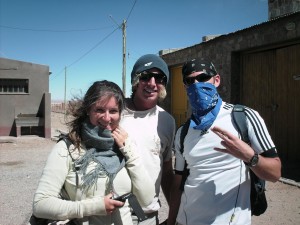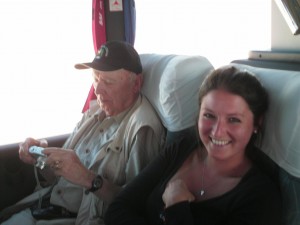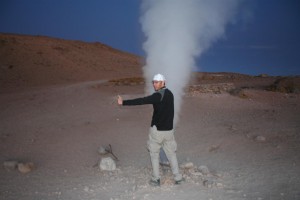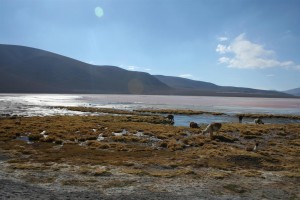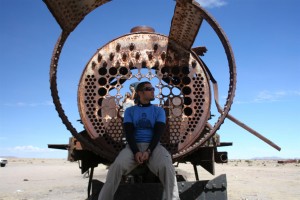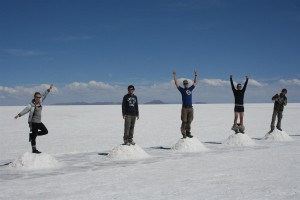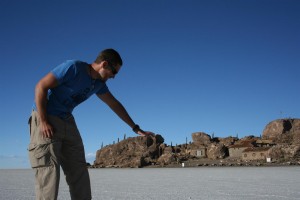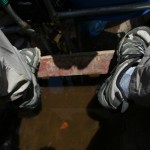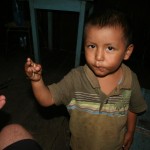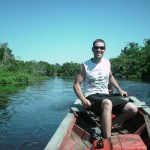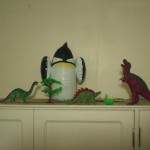
“I never said it would be easy, I only said it would be worth it.”
These words have never been more applicable than when referencing the Jungle Trek to Machu Picchu. I arrived at Cusco with an email directing me to come to Loki Hostel and see if they had room for me. I arrived at an early hour, so decided to make use of the internet and restaurant for the first half of the day. Vikki, the tour desk girl was invaluable; giving directions, insight, booking Spanish lessons and tours. If anyone ever goes there, please give her a hug for me.
Cusco is an interesting city, apparently the only job available there is shoe-shine-boy, but somehow these same people were able to save up enough scratch for a church like this one.

Mauricio, a Colombian gentleman working for the U.N., and I were booking our trips at the same time and went to the tour agency for a debreifing at the same time, so we became somewhat acquainted with one another during the process. The trip to Machu Picchu ranges wildly in cost depending on what tour group you go with, and this particular group charged $185, or $170 for students. Amerigo, the pseudo Italian gentleman who runs the show, quickly passed us off to one of his guides and that was the last we saw of him for days. The guide gave us a quick run down in mild English on the days ahead and we went back to our hostels to sleep and await the 7:30 arrival of the guide the following morning.
7:30 came and went. 8:30 came and went. Finally, a large blonde Canadian tourist came stumbling into the lobby at Loki to inform us that the car is actually a few streets away, and instead of picking us up, we would have to walk to it. Thus it began.
Our van finally got underway around 10 am, which was no problem because we still got a full day of mountain biking in through rain and waterfalls, alongside gutwrendhing drops, and in great company. Our band was a great mix of people from around the world, mountain bikers from Wales, and abrasive woman from Canada (from whose many wonderful one liners came “My stomach can eat my ass!), scattered Americans, and a Kiwi; everyone spoke English, which worked out well for me.
By mid-afternoon we had all reached a tiny little town called Santa Maria. The 4 day members of our group all went to the hostel to get acclimated and Mauricio and I went down to the center of town to get on our transport to the next city, Santa Theresa. Transportation which we had assumed was already arranged. We were wrong.
Due to the recent rains, the road between Maria and Theresa had suffered a large amount of landslides. 7 or 8 of them were currently being cleared by work crews and a significant number of cars and people were trapped on the mountain roads waiting to get to Santa Maria. This information was accompanied by the revelation that our tour guide had not, in fact, arranged our transport onward, he had simply expected to find a car heading that way and stuff us into it. We were in for a wait.
Mauricio and I are of a similar sort that we are not the type to sit around, so we promptly set to work making friends with the dozens of people similarly stranded around the town center. Hours later, our biking group came into town to grab some dinner. We took the opportunity to sit down and eat with them and find out what their day was like. They were all rather impressed with the owner of the hostel, Fabio, and his coffee growing operation behind the hostel that he claimed to operate at a loss in order to employ some local labor. My experience of humans, especially Latin Americans, is that absolutely nothing is ever done at a loss. Regardless of my opinion, the guy seems rather cool when we finally got back up to his hostel. Mauricio and I had opted to change our tour to 4 days, as it doesn’t look like we have much choice. It was near 11 p.m. and the roads are not cleared yet.
After a while playing cards at the hostel with our group the guide, Angel, came to inform Mauricio and I that we need to get our bags because he is sending us off to Santa Theresa. Following this thunderbolt, Fabio pulled Mauricio and I aside and expresses his concern for our wellbeing and asks us to reconsider braving the mountain roads at night. Whether this was him trying to get paid for two more guests or genuine concern for another human I will never know, but I agreed with him. When we brought this up to Ange, stating that we were NOT leaving and would be remaining with the group, Angel chose to inform us that this would invalidate our tickets to enter Machu Picchu and return to Cusco thereafter, leaving us high and dry. Lovely.
Walking back to the town center was no picnic. The rain had taken questionable dirt paths serving as roads and turned them into shifting mudbaths. This sort of thing doesn’t bode well.
Around 11 p.m. we finally got underway through some undesirable and undependable roads. Around 12 a.m. our shuttle stopped in the middle of the road. The driver informed us that it was too dangerous to drive anymore so he was going to stop here for the night. Trying to catch any sleep was next to impossible, as I kept slumping over and hitting my head on the window, waking myself up again.
Around 3 a.m. things started getting interesting. A number of flashlight bearing, poncho clad europeans materialized out of the darkness and opened the door to the van. The resultant session of verbal abuse revealed that these people were force marched all day with no food and no dinner. They were told to walk into the dead of night and did so until nearly 11 pm when they happened across an old Peruvian woman who was finishing up her yard and invited them all in, made them supper, and gave them blankets to sleep on her floor. Then around 1 a.m. their “guide” came back to wake them up and tell them he had procured transport to take them to the next city. Waking them up and marching them out into the night again in the rain. They were then told to purchase flashlights and pochos at the next town as they would be riding in the back of an open cattle car truck with no protection from rain or cold to reach the transport that had already been paid for but whose driver had SOLD THEIR SEATS to locals, Mauricio, and myself. Upon arrival the “guide” asked them all to produce another 10 soles a piece in order to pay the cattle car driver. At this point, I thought I was going to witness a murder. The told the guide that he would need to have the agency pay his impromptu driver and then asked the guide if he would like to further press the issue and be left in the mountains. He wisely settled the debt himself.
The beautiful Polish girl next to me confided that she had paid nearly $300 dollars for this trip and so far it had been something akin to a prison camp. I love Polish accents. Mauricio and I feel a good deal better about our lot in life now that the rain has mostly stopped and we have to push on to reach Santa Theresa. The walk isn’t unpleasant, but it is no walk in the park. After a while we come to another distinctly obstructive road block. The faint at hear have turned back as it is still peppered with cascading stones of varying sizes; some nearly the size of semi-truck tires. The bold are running through the mess. The crazy are standing in the middle of it shooting video of the stones falling around them. Guess which category I fell in to?
The sign for Santa Theresa was a welcome sight. A short while later we rolled into town tired and a bit bedraggled. Our directions of “Find Nancy” actually turned out to be much better than we expected. After 30 minutes or so of talking to the locals, we landed at Nancy’s hostel which was apparently run by her 13 year old daughter. Nancy wasn’t there, so Mauricio passed out fully clothed on the bed and I strolled around town for a little while, unable to shake a feeling of unease. Eventually, I came back and lay down for a while, catching a blessed 2 hours of sleep.
After waking, I rousted Mauricio and we set to work making a plan. We had to figure out a few things:
- How to get out of this town
- Which way to go
- Where was Nancy
When we asked the young girl who I still believe ran the entire hostel herself where Nancy was, she told us that there were actually two Nancy’s in town; textbook “you couldn’t have told us earlier.”
The REAL Nancy was one street over, a good distance for a 4 street town, and was abundantly informative. The guide that we were supposed to link up with left town at 5 a.m. while we were walking through the landslides. With no clear path forward or back, Mauricio and I are forced to consider our options.
There were some taxis heading back down the road we had walked in on, but we knew they would only make it as far as the slide, then we would have to find another means of returning and that meant giving up on Machu Picchu; something neither of us was prepared to do. As we were talking a local teenager came in to the hostel, blue jeans and purple crocs, and gave us a nod. Looked like someone had finally cut us a break.
While speaking with Nancy and the local boy, our erstwhile group came stumbling in to town. Some elated reunion moments and we were all to be disappointed again when Angel told us that we two had to press on, guide or not. With the faith that only the Virtuous know, we left; accompanied by Xavier, his purple crocs, and instructions from Angel, “There will be people waiting at the train depot with your names on a whiteboard. If not, I think they usually stay at Hostel Jon.”
So our new local friend Xavier led the way with his purple crocs. We walked through water, rain, canyons, jungle, and just about every kind of terrain you can imagine. We even had to cross a river at one point on some crazy cable car contraption that “only killed 4 people last year.”

Eventually we arrived at a checkpoint for entering a train station; the end of the line somewhere in the middle of nowhere. Xavier told us that we had to pretend not to know him, as for some reason that no one was able to understand, the guards would not let us into the train area to buy tickets if they knew Xavier had led us there.
For the cost of 20 soles we were led through darkness and confusion by the purple all-terrain crocs of a 16 year old boy, when the combined efforts of numerous grown men and women and the added benefit of experience and thousands of tourist dollars had failed to accomplish anything that could ever be mistaken for a successful operation. Congratulations Peru.
The train led to Aguas Calientes, the town closest to Machu Picchu, where we debarked and looked around for the mystical individuals with a whiteboard. I don’t have to tell you the outcome.

In walking the city, Hostel Jon was easy to get directions to but rather hard to find. Eventually we found a sign that said ‘Hostel Joe’ and went for it. As we approached, sequestered behind another sign was a smaller placard reading ‘Hostal John.” Inside, god-forbid, was a woman writing our names on a whiteboard. We had to get a picture.

No one knew where our new guide was, but they did know that we had a room at another hostel. We stumbled across some of the other people we would be going with in the morning and they told us that our “guide” would be at a certain restaurant near the plaza.
Thus, safely within reach of Machu Picchu, Mauricio could devote ourselves to well earned hot showers. The town was named Aguas Calientes, after all. Not surprisingly, the hostel that we were holed up at, some unpronounceable name in a long desiccated local language, which professed to have hot water, had nothing of the sort.
Dinner came and our “guide” was as surprised to see us as we were to finally see him. In a lightning strike of fortune, the guide produced our tickets to Machu Picchu, and our return train tickets to Cusco along with my ID card they had used to get a discount on my ticket. This was also a surprise to all the other people we were eating dinner with, as none of them had been given their tickets yet, and when they were finally given their tickets, they were told they needed to pay another $15 dollars for the train.
Folks, this up-selling is an all-too-common trend. When faced with this, the best course of action is simply to refuse to pay the extra and walk away. These people entered into a contractual agreement with you, and you DO NOT have to pay for their idiocy. As soon as you have your ticket/food/ride, you are no longer held hostage. Don’t buy into it.
Mauricio brave, and clean, soul that he is decided to take a shower in the arctic water of our cursed shower. I gave it a pass and decided to simply smell bad for one more day.
4:30 a.m. comes early. The bus to Machu Picchu, a $7 and priceless ride, begins transporting people at 5 a.m. Mauricio and I got there before the bus but after about 200 people in line. Luckily, the group we ate dinner with was in line much earlier than us and we skipped forward a hundred people or so in line. This is key. Only 400 people, first come first serve, are allowed on to the Wayna Picchu mountain within the park. I only found this out the day before, but as you will see it is something of a big deal. Machu Picchu was worth every bit of nastiness we endured.
Throughout the day, I met numerous people, including a German girl, Viola, I had seen in several cities recently, and a marvelous Peruvian girl with the Arabic name Zulema who hiked Wayna Picchu with Mauricio and I.
I cannot find words to describe this place. It has withstood massive earthquakes without losing a stone; earthquakes that have leveled many other cities nearby. It is beautiful and strong, and it was abandoned. Go. Just go.


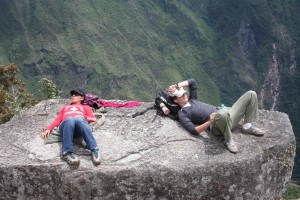






After Machu Picchu, we were tired; bone tired. It had been a long several days at high altitudes. For some reason, I had the bright idea of walking back down the unending stair case from Machu Picchu to the base of the mountain and then back into town. It was just rough.
Aguas Calientes is named such for some thermal hot springs that are situated a bit above town. Mauricio and I took some well deserved rest and sat in the pools for most of the remainder of the day. We met a ton of people there, Koreans, Europeans, Americans and everyone was abuzz with the wonderment of the day.
Finally, after yet another reunion with our first tour group, we went down to the train station. We were told, yet again, that there would be people at the train station with our names on a whiteboard waiting for us. Robbed of our faith in humanity, but renewed with our faith in ourselves and our unending resourcefulness, Mauricio and I boarded a train bound for Ollantatanbo; a city still 1.5 hours by car from Cusco and our questionable reservations at Loki.
Exiting the train, we climbed a hill with the rest of the struggling masses, seeing several people with signs, though none with our names. Finally, cresting the rise, we found our drivers.
They ushered us quickly, along with several others, up another road to a parking lot with a blessed white microbus waiting to take us to warmth, a bed, and salvation. There was another train arriving an hour or so later with the last member of our return bus group. The bus drivers told us that that train had broken down somewhere and there was no word on when it would be arriving and we had to leave without them. True to form, they were lying to our faces, as the train pulled in to the station as we were driving away. We stopped and collected our last man and went on our way. I have seldom been so happy to see a bed as I was when I returned to Loki. True to form, they had somehow lost my reservation, but had a last minute bed that I could use going forward.
The next day I went to the Loki tour desk and explained what had happened and Vikki called Amerigo and had him come over to the hostel. After much conversation, and a little help from Mauricio, I was refunded enough money to rent a Honda Hurricane 250, a complete set of safety gear, and pay for a tank of gas the following day. Score.

The following morning, Sunday, I wandered down to the motorcycle shop and happened to meet a guy named George who was renting a bike and taking off with a small group of people on a tour of the Valle Sagrada. As we were waiting on the street a smallish girl with a too-large helmet on the back of another motorcycle asked me if she could ride with me for the day. This can mean trouble.

She had hired the other bike and man as a guide for the day and opted at the last minute to ditch him and ride with the random stranger on another bike. Ballsy, I had to hand it to her. Some hours later after we stopped for lunch, I was to discover she was not only ballsy, but the most attractive British girl I had ever met.

A long and amazing day on the back of my bike saved her some money and gained her some bruises when I caught a rut the wrong way leaving an Incan salt mine. A quick left hand low side left her quite shaken. I was nearly untouched with legs and arms and boots and helmet, but she scratched and bruised her left leg at angle heel and hip. Trooper that she was, she insisted that we drive on to go see other ruins once the rest of the crew had driven back to Cusco.

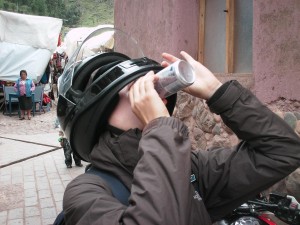
If you are reading this, I tell you now as a friend, do not ride Peruvian roads at night. NEVER ride Peruvian mountain roads at night. In my collective life I have never honked a horn more than I did in that single night riding across Peru. Blind mountain corners must be preceded by significant honking as you go through the turn to let someone know on the other side you are coming. The heart-stopping moment comes when you hear the replying honks and you have to wonder what lane they are in and how big the oncoming projectile is. There were times when we were driving along and suddenly the road simply was not. In the space of 2 meters where the light shone, the road simply ceased to be and I had to throw the bike into the adjacent (read as Oncoming) lane until the collapsed road had come back again. This was not uncommon.
Finally, we stopped about 15 kilometers from Cusco at a small gathering of buildings and asked for some hot tea to stave off the chill of the last few hours of riding. We were nearing 4000 meters above seal level (over 12,000 feet) and it was not cold or friendly. Stopping for a while on Domingo Santa (Easter Sunday) we got to eat some neat looking pastries baked on questionable construction paper and weak but hot coca tea accented by some coca leaves I had in my pack. It was a godsend.
Riding into Cusco, we got to say hi to Neon Jesus and some of the locals with their extremely accurate directions around the one way streets to get back to the center of town to return the helmets and bike to the rental agencies. After returning her to her hotel and finishing the exit formalities, I had less than an hour to get to Loki, retrieve my bag and make it to the bus station to catch my next 20 hour bus to La Paz and my new couchsurfing friends. It was time to move.
This short bit of history would not be complete without ending it with a huge thanks to Mauricio, Hannah, Vikki, and the many other people in this tale who made this a harrowing and lively tale of success and teamwork. Thank you all!


